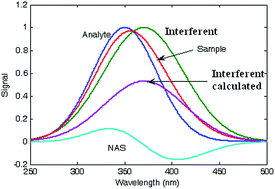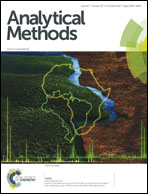Net analyte signal based interferent modelling (NAS-IM) for solving matrix effects and unknown spectral interferents
Abstract
Processing of the standard addition data by using the net analyte signal (NAS) was introduced for analyte determination in the presence of matrix effects and spectral interference caused by unknown interferent(s). For solving matrix effects, standard addition was employed. By defining a vector which is the NAS for unit concentration of the analyte and correction of the analyte and the sample spectra for it, it was possible to obtain the spectrum of the unknown interferent(s). By using this method, a good estimate of the spectrum of the unknown interferent(s) was recovered. Both simulated and real data were employed to show the validity of the proposed method. Analysis of the simulated data by the proposed method showed that it is possible to resolve a good estimate of the spectrum of the unknown interferent(s) even in cases where the signal of the interferent(s) is up to 120% of the signal of the analyte with extreme overlapping of the spectra. In the next step, the resolved spectrum of the interferent(s) and the spectrum of the analyte were used to determine the analyte concentration by H-point standard addition. Real data were acquired from the standard addition of carvedilol to urine and standard addition of benzoate to a soft drink.


 Please wait while we load your content...
Please wait while we load your content...